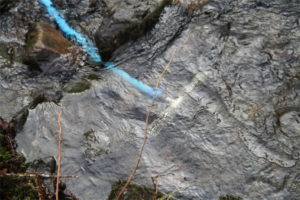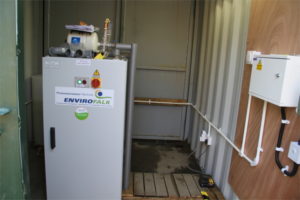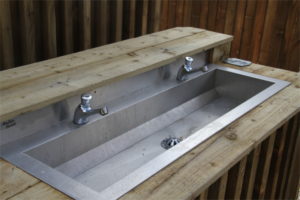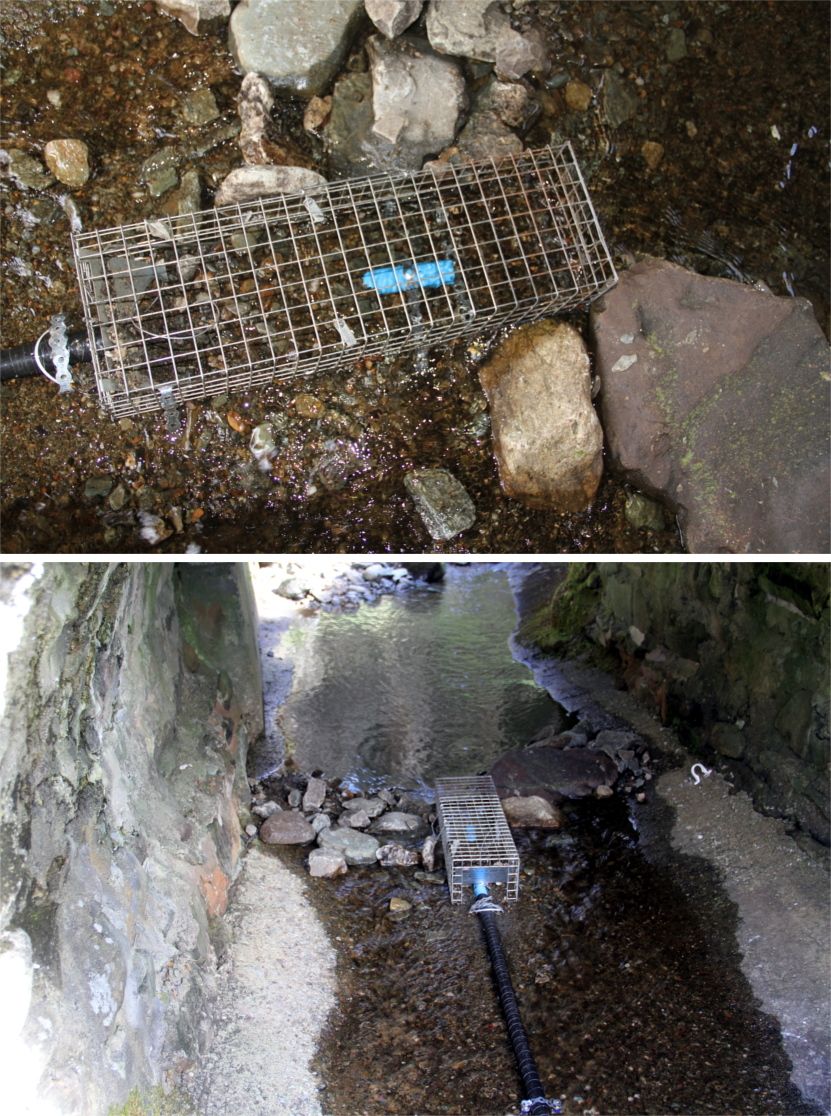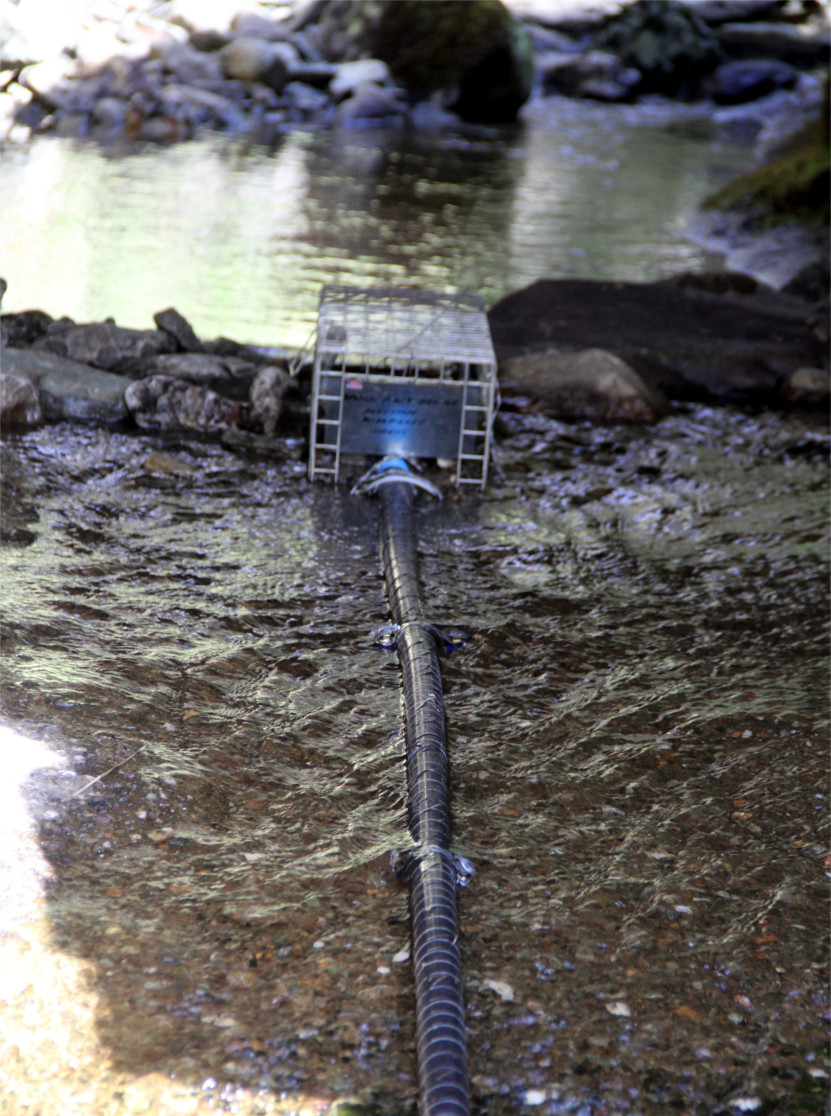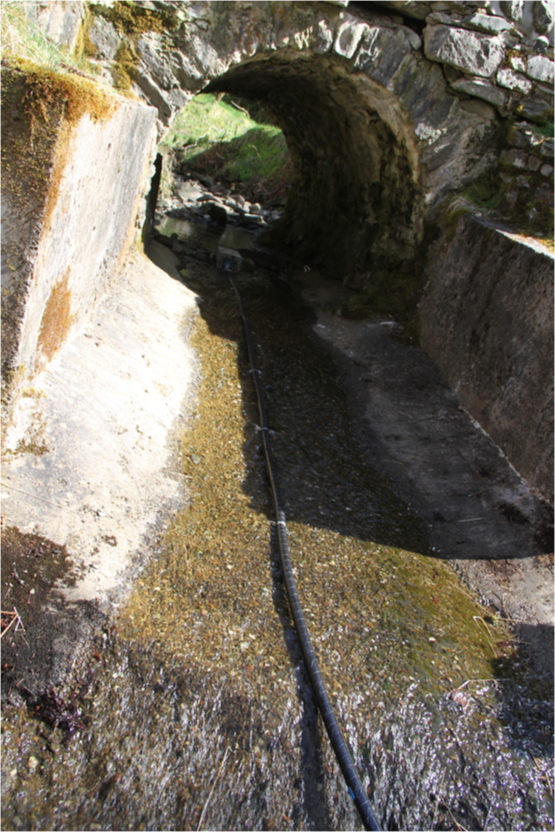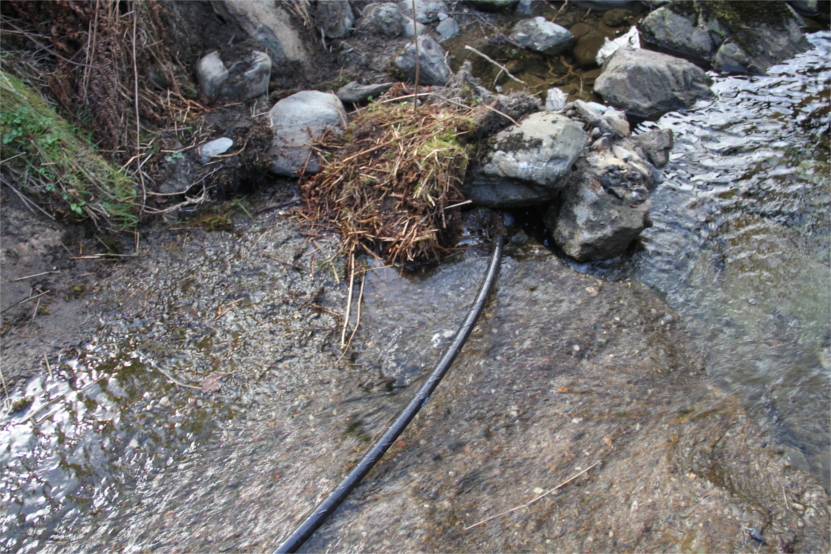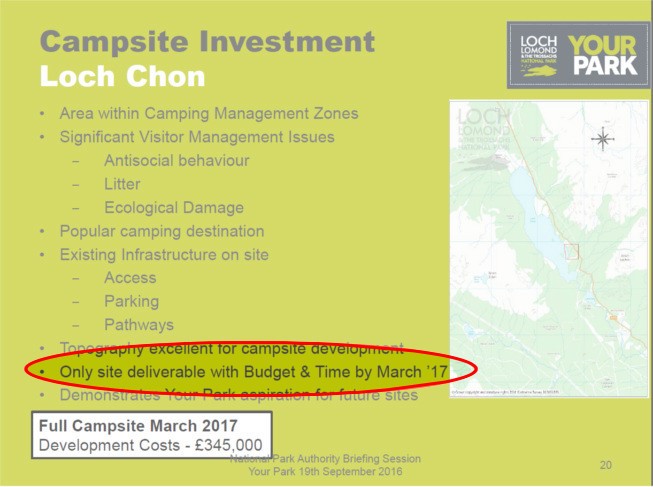
By Ross MacBeath
What differentiates a campsite from wild camping? Most people would say at the very least the existence of services such as the provision of drinking water and toilets. The evidence from my visits to Loch Chon the Loch Lomond and Trossachs National Park Authority cannot even provide a reliable water supply for the £7 a night charge (see here for post and here for a set of photographs of wider issues with the campsite).
The reasons why the water supply at Loch Chon is defective
One of the first principle of designing a private water supply it to ensure the availability of water from the source stream by carrying out a year long study of peak water flow. What follows below shows that these investigations were either not carried out or ignored but its worth considering first why the LLTNPA has behaved in this manner..
Gordon Watson at a Public Meeting with Strathard Community Council on the 4th July 2016 stated that the Loch Chon campsite was chosen for it’s suitability and merits as a campsite rather than its availability. The slide above, which was obtained subsequently through FOI, shows that this is not true and that Loch Chon was the ONLY option that would allow the LLTNPA to deliver the number of pitches they had promised to Scottish Ministers by 1st March to enact their byelaws.
What this shows is that the LLTNPA intended to build a campsite at Loch Chon no matter what. For how the LLTNPA dealt with its planning permission to itself (see here). This is reprehensible behavior on all counts and LLTNPA are quite clearly paying the price with a defective water supply. But ultimately it’s visitors and communities who will pay the real price for this unwarranted development going forward.
Peak water flow and the LLTNPA Loch Chon water supply
An unsightly installation with loops in blue water pipe makes a poor impression. When taken together with the positioning of the intake manifold, which is partially out of the water, unsecured and likely to be dislodged the first time the stream is in spate, it provides a rather damming but realistic indication of what was initially installed.
Just while we’re looking at this image, you can see that the concrete floor of the culvert under the bridge is smooth and curved. This is done intentionally to stop materials collecting on the surface. When the stream is in spate, large boulders are transported in the torrent of water and the smooth culvert base ensures they can roll right through preventing them from causing an obstruction under the bridge. We will see why this is important later in the article.
Another important factor in providing a water supply is water pressure
One measure of the effectiveness of the water supply is determined by the water flow from the taps, which is of course dependent on the water pressure. Water pressure in turn determined by the difference in elevation between the tap and the intake manifold. The greater the height between the two the greater the pressure.
At this development the Park Authority have chosen to place the intake manifold almost 2 metres underground just by the road bridge over the stream though it is still above the level of the taps which are further down the slope. Not sufficiently high though to provide a sufficient head of water which is responsible for many of the issues with the water supply. It would seem clear then that the intake manifold is in the wrong pace. It’s a basic design flaw and still goes uncorrected even though the LLTNPA is aware of the fact.
An essential requirement is that the intake manifold is always underwater
You would think that making sure the intake manifold is always under water would be a given. Yet here we are at Loch Chon on the 12th March 2017 with the manifold almost completely uncovered drawing air into the system.
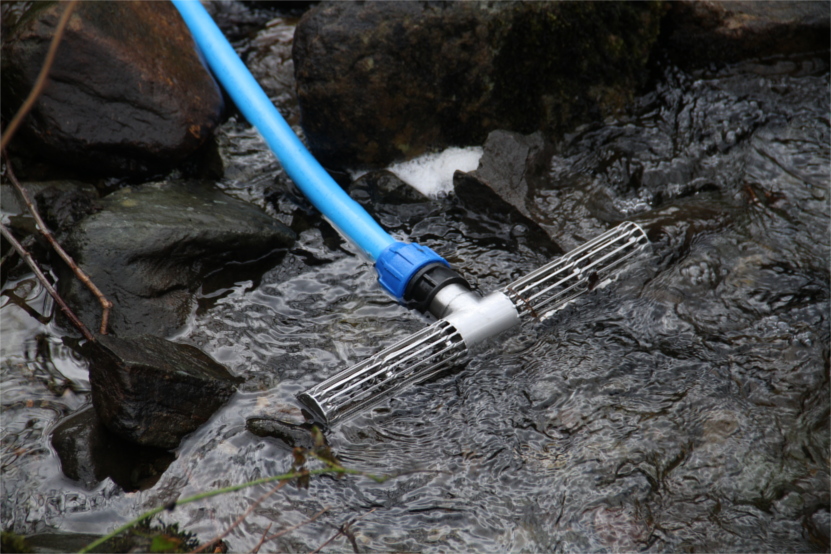
The problem is clear that the stream does not have sufficient water flow in dry periods. This was evident during a dry spell starting before March 1st and through 12th March when the water supply failed intermittently when the intake pipe was not fully submerged causing air to be drawn into the system. In this location there is sufficient depth of water the intake is just not positioned properly.
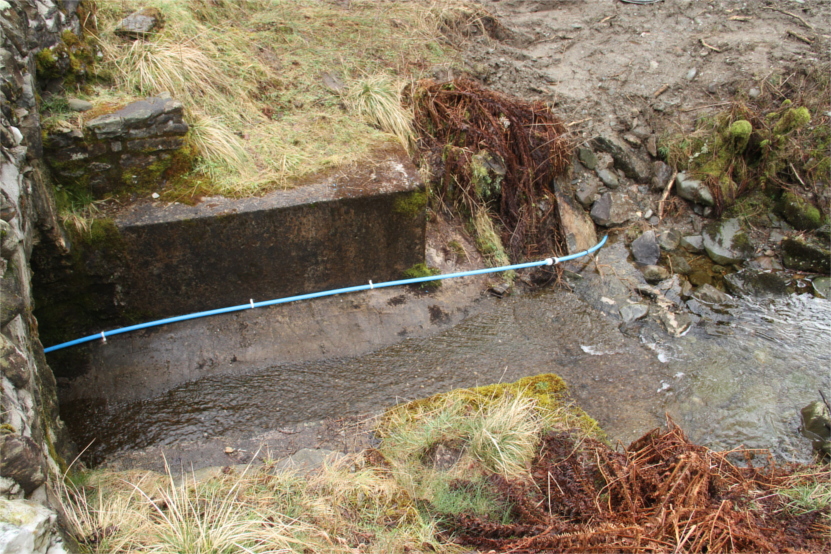
Of course once the air lock is in the system it won’t self clear easily as water won’t flow up hill. So many basic principles have just been overlooked cumulatively resulting in poor system design. This is a contributory factor together with the failure of staff, the clerk of works and the contractor to understand the basic requirements for implementing such a water supply.
One must ask who is managing this project, clearly the people involved with the development at Loch Chon have little or no understanding of stream feeds to private water supplies or their design. This lack of capability is worrying in an organisation which claims to wish to provide more campsites. The LLTNPA is evidently not up to the task.
One week later the water was partially on, there was drinking water but no toilets
One week later on the 19th March 2017 the intake pipe was submerged once more, after some rainfall, however the water to the toilets and wash hand basins was still off. You can see here the pipe had been removed from the clips removing the ridiculous upward loops in the water feed pipe.
The water supply was still causing issues, drinking water was available but toilet flushing was not.
Two weeks later there is still no effective water supply
On the 2nd of April the water supply was again only partially functioning the intake manifold was submerged and there was water. This time while one toilet was working the drinking water wasn’t. 3 of the 4 toilets remained locked. The disabled toilet wass open and functioning with wash hand basins.
Another week on engineers were working on the system and some water was flowing
10th April 2017 – Water was now available from the outside taps though pressure was so low the auto shut off taps fail to operate correctly. Well at least there was drinking water on site. Although container filling took a while, it was better than nothing.
Again only one toilet was unlocked but I am pleased to report it was flushing and the wash hand basin was operational. The other three toilets remain locked and strangely it was not the disabled toilet that was open.
It had taken the LLTNPA well over a month since the date the campsite was officially open to get even a basic water supply in place. This was my first visit where toilets and drinking water have been available together but it is clear the LLTNPA are not out of the woods yet with low flow rates and intermittent supply. The test will be when all 4 toilets are in operation and water still comes out of the taps.
The engineers were working on the system when I arrived and allowed an opportunity to see whats inside the container next to the toilet block. It does look like there is a leak in the container roof.
The confusion over the hot and cold taps had also been sorted and there were now neutered tap tops both supplying cold water.
The LLTNPA have been busy correcting some of the issues above and creating others
My visit on the 10th of April 2017 showed some changes. The main visible differences one week on were up by the intake manifold. They had cut the pipe back and fitted a black sheath which is far less intrusive. The had also removed the old stainless steel manifold and fitted a cage to cover the end of the pipe. However the pipe end is open and directly facing into the water flow with nothing to prevent pebbles and smaller items being transported down the stream from finding their way into the system, so anything smaller than the mesh can also enter the intake pipe. I think this may pose a problem for the future, potentially causing blockages in the intake pipe and significant costs and disruption to clear it. Some form of strainer or baffle is surely required.
Click on images for zoomed view
The second and most important is the placement of the intake port on to the surface of the culvert, these images are very telling considering the recent weather has been wet followed by a short dry spell, the level here has dropped 20 cm since last checked.3 weeks ago.
This indicates the Peak flow of the stream may be very small in dry weather.
The problem is clear, the peak flow of the stream on dry days is so small that the water level in the culvert is no more than a centimetre or so and doesn’t even cover the intake pipe. To solve this a small dam, and I mean small, has been created with stones and gravel where the depth of water behind this is sufficient to cover the intake pipe.
Culverts are designed to prevent debris collecting
As we discussed already, the smooth curved floor of the culvert is designed to prevent debris collecting in this location. The Debris (dam) (photo above) will be removed by fast water flow.
Even with the current level of water flow the smaller stones and gravel around the intake pipe will be washed away eventually breaking the dam causing the water level to drop below the intake pipe and the water supply to fail.
In Spate the stream will remove all debris
With any heavy rain storm the stream will be in spate, the force of water will clear all of the rocks forming the dam in the culvert. When in spate the stream can also carry branches and fallen trees down through the culvert but now with the fixed obstruction of the mesh cage there is a possibility that these will damage the cage or more likely get jammed on it causing a build up of debris in the culvert. This is not good practice and I would think it should be avoided.
The arrangement of the pipe has changed, now entering the river bank at a much lower level, the pipe is not secured on it’s traverse across the culvert and the gap underneath will most likely collect sticks and other vegetation then a build up of debris will possibly occur.
Two months on and no further forward.
Around 2 months since the water problems became public and it would seem we are right back where we started with an intermittent supply determined by rainfall. The National Park Authority really have to get their act together on this and stop penny pinching. There is a problem with the water supply and it’s clear what it is. In dry spells there is no water. Get it sorted! The solution is simple providing the stream does not dry up altogether, and only time will tell if that’s going to happen.
One thing remains clear, the LLTNPAs current solution is unlikely to work effectively even in the short term.
The real problem here is systemic failures within the LLTNPA
The LLTNPA Board should have been well aware of these problems as some apparently visited the campsite but have denied their existence in almost every public forum, even at their own board meetings. I’m aware of one occasion where their spokesperson stated “As with any new site, there have been some snagging issues such as the running water which was unavailable for a few days due to a temporary problem with the new connection” at least finally giving a nod to a problem everyone knows exists. 41 days of no water, limited water or intermittent water supply is hardly reflected by their “temporary problem”. I believe it’s clear from the series of images here that the problem has existed from the beginning and the vagaries of Scottish weather has determined if water was available or not. The solutions created just promise more of the same – an ineffectual, intermittent water supply.
See here for video on the 19th March and here for the 2nd April
In the strange world of infallibility the LLTNPA inhabit even when they’rere wrong, they say they’re right and put out statement claiming all is well, whether it’s true or not. This was certainly what happened at their board meeting on the 13th of March when numerous board members patted each other on the back for a job well done at Loch Chon and for getting the site finished on tiime. This was witnessed by seven members of the public but should have been recorded for all to see. Quite a surreal experience to see a National Park Authority behave in this way.


